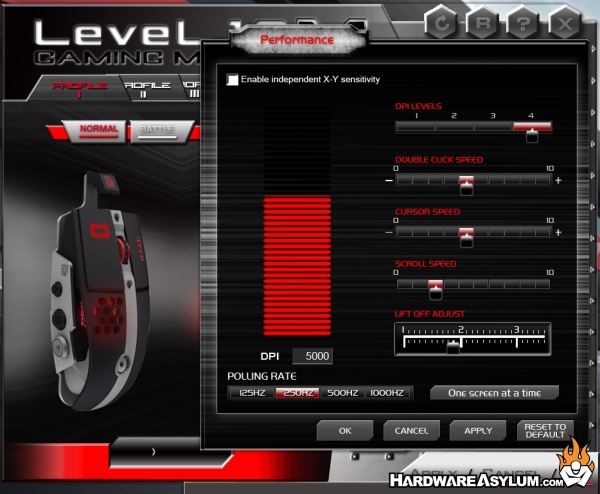Thermaltake Level 10 M Gaming Mouse Review
Author: Dennis Garcia
Published: Friday, December 28, 2012
The Software and Testing
The Software
Like most mice, the Level 10 M can function right out of the box using the system drivers. But to really get things to shine you need to install the software suite. Software is provided in the box but I always recommend downloading the latest drivers directly from Thermaltake.
I arrived at the Download section of the Thermaltake website and discovered there is already a firmware update available for the Level 10 M mouse. No description of what is addressed but I went ahead and used the tool to quickly and painlessly update. Next the Mouse Driver (Version 1.1) was installed. No issue despite my use of Windows 8 and the footprint is small.
I arrived at the Download section of the Thermaltake website and discovered there is already a firmware update available for the Level 10 M mouse. No description of what is addressed but I went ahead and used the tool to quickly and painlessly update. Next the Mouse Driver (Version 1.1) was installed. No issue despite my use of Windows 8 and the footprint is small.

The software is attractive and robust showing the input from the pros was not just in design. Five separate profiles are available and each can be changed from a dropdown allowing for each profile to be changed matching your current gaming needs. There are even links to the videos to describe the airflow and 3D axis features.
One of the more interesting features is the Battle Detection. This setting set the lighting effects to change based on the clicking intensity. This looks pretty awesome with the lights off!
One of the more interesting features is the Battle Detection. This setting set the lighting effects to change based on the clicking intensity. This looks pretty awesome with the lights off!

In addition, you can manually select your accent lighting, record, tune or load macros, adjust performance settings and individually maintain your profile settings. All of the changes are accompanied by an on screen popup that confirms the change without taking your eyes off the game.
Testing
There is no doubt the Level 10 M Gaming Mouse looks amazing. But how does it perform? I used the Level 10 M exclusively for a couple of weeks. After some individual tweaking the first couple of days I found the shape felt really comfortable though it did lead me to dragging my wrist a bit more than my ROCCAT Kone [+] due to the longer low shape. One side effect of the design is a hefty 185g weight that is not adjustable.
I settled in at 3200 DPI initially but found the 5000 DPI setting to be crisp and responsive for gaming. Several lengthy Borderlands 2 sessions along with some twitch inducing Team Fortress 2 play confirmed the responsiveness is not an illusion.
I found myself letting my left thumb rest on the top of the left side aluminum rather than between the buttons if I was not paying attention. Perhaps some additional tuning of the palm rest would have helped to reduce the dramatic angle. And to be nitpicky, I had to shift my fingers to see the DPI lighting on the right side. Of course everyone's fit is different!
I settled in at 3200 DPI initially but found the 5000 DPI setting to be crisp and responsive for gaming. Several lengthy Borderlands 2 sessions along with some twitch inducing Team Fortress 2 play confirmed the responsiveness is not an illusion.
I found myself letting my left thumb rest on the top of the left side aluminum rather than between the buttons if I was not paying attention. Perhaps some additional tuning of the palm rest would have helped to reduce the dramatic angle. And to be nitpicky, I had to shift my fingers to see the DPI lighting on the right side. Of course everyone's fit is different!

